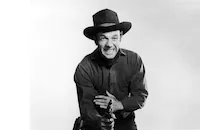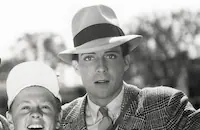Fort Defiance
Brief Synopsis
Cast & Crew
John Rawlins
Dane Clark
Ben Johnson
Peter Graves
Tracey Roberts
George Cleveland
Film Details
Technical Specs

Synopsis
Civil War veteran Ben Shelby arrives at the Tallon ranch in the Arizona desert. After he saves blind Ned Tallon from being trampled by a spirited horse, he encounters Ned's uncle Charlie, who is suspicious of Ben's claim that he is a friend of Ned's brother Johnny. When Ben learns that Johnny is expected at the ranch soon, he offers to help Ned and Charlie while he waits for Johnny's arrival. As time passes, Ben and Ned become friends. Ned speaks with pride of his brother's medals and war honors, and Ben reveals that his younger brother was killed during the war. One day, Charlie returns from nearby Fort Defiance with news that the U.S. government intends to round up the local Navajos and move them to a reservation in the Oklahoma Territory. The angry Indians have hidden in the rugged canyons surrounding the area and are making raids on the white settlers. When Ned asks for news of Johnny, Charlie reluctantly discloses that he was killed during a bank robbery. Hearing that, Ben reveals that he came to Arizona to kill Johnny, whose surrender to the Confederates during the Battle of Tennessee Ridge caused the deaths of many soldiers. Ben, the only survivor, lost his brother. His illusions shattered, Ned asks Ben to stay, but he is eager to rejoin his wife, and rides into Fort Defiance. In the saloon, Ben starts to write his wife with details of Johnny's betrayal, then changes his mind and returns to the ranch to form a partnership with Ned and Charlie. Unknown to Ben, Dave Parker, whose brothers were also killed at Tennessee Ridge, has found his letter and is now determined to kill Ned in revenge. During a shootout at the ranch, Charlie sacrifices his life so that Ben and Ned can escape. While Ned and Ben hide in the canyons, Johnny, who is not dead, returns to the ranch. Learning what has happened, he and his friend Hankey track the two fugitives. When Johnny reaches the men, Ben, apprised of his identity, tries to kill him, but is disarmed by Hankey. Their skirmish is halted when they are forced to defend themselves against an Indian raiding party. Hankey is killed and the other three men decide to head for a little-known pass, hoping to escape further encounters with the Indians. The next day, however, they see a stagecoach under Indian attack and ride to help the passengers. That night, the Indians gather nearby. While the men prepare for a morning battle, passenger Julie, a disgraced dance hall hostess on her way to San Francisco, talks with Ned. In the morning, the Indian attack is interrupted by the arrival of the Cavalry. Ben then tells Johnny that he will forget about seeking revenge for the death of his brother if he will allow Ned to remain with him. Johnny refuses, determined to take Ned to San Francisco for an eye operation. At Fort Defiance, however, Ned tries to kill Johnny, who realizes that he has lost his brother's love. Because Ned refuses to take any of the money Johnny stole to fix his eyes, Johnny forces Parker to buy the Tallon ranch. After giving the money to Ned, Johnny goes after Parker. During the gunfight, Johnny is killed along with Parker's men. Ben then kills Parker. Julie agrees to marry Ned and make a new start on the ranch. As they and Ben prepare to leave Fort Defiance, Ben's wife arrives on the stage to join them.

Director
John Rawlins
Cast

Dane Clark

Ben Johnson

Peter Graves
Tracey Roberts
George Cleveland
Ralph Sanford
Iron Eyes

Dennis Moore
Craig Woods
Dick Elliott
Bryan Hightower
David Rawlins
Jerry Ambler
Kit Guard
Wesley Hudman
Hugh Hooker
Duke York

Lee Phelps
Crew
Eugene Anderson Jr.
Frank Beetson
Iron Eyes Cody
Stanley Cortez
Lucius Croxton
Wilton R. Holm
Charles Kerr
Charles Kirk
Irving D. Koppel
Louis Lantz
Frank Melford
L. John Myers
Louis Phillippi
Tom Pratt
Paul Sawtell
Clifford D. Shank

Videos
Movie Clip


Film Details
Technical Specs

Articles
Fort Defiance
The part of Tallon is played by Dane Clark, a Brooklyn-born actor better known for roles in crime dramas set in contemporary cities. Clark made his film debut in 1940 and got his first big break in the Cary Grant-John Garfield war movie Destination Tokyo (1943). Over the next few years he got lead roles in B pictures and good parts in major productions supporting such stars as Bette Davis, Humphrey Bogart, and Ida Lupino. He also went into television early, appearing on both The Chevrolet Tele-Theatre and The Ford Theater Hour in 1949. Clark's career continued solidly through the 1980s, frequently on television crime dramas in his later years. He also directed a few TV episodes between 1958 and 1960. Clark died in 1998 at the age of 86.
The role of the sensitive blind brother went to Peter Graves, his third film in a busy career that lasted up until his death in 2010 at the age of 83. Graves, the younger brother of James Arness of Gunsmoke fame, also did the bulk of his work on the small screen, notably as Jim Phelps on the long-running Mission: Impossible series, which won him a Golden Globe Award in 1971 as Best TV Actor in a Drama, and as the host of Biography from 1993 to 2006. But movie audiences will always remember him as the loopy pilot Captain Clarence Oveur of Airplane! (1980) and Airplane II (1982), who constantly asks inappropriate questions of his young passenger Joey.
Fort Defiance was filmed on location in Gallup, New Mexico. The production's headquarters was at the legendary Hotel El Rancho, built in 1937 by R.E. Griffith, brother of pioneer director D.W. Griffith who encouraged many productions to use the facility because of the hotel's rustic elegance and its proximity to photogenic Western landscapes. The El Rancho was a popular location and home-away-from-home for many Hollywood stars, directors, and crews from its inception until sometime in the mid-1960s. The historic hotel has been well maintained and restored and is today a popular Gallup tourist spot.
The chief Navajo role, Brave Bear, is played by Iron Eyes Cody, arguably the most famous of all Hollywood "Indians," thanks largely to his appearance as the weeping Native American surveying a polluted landscape in a long-running series of "Keep America Beautiful" public service spots on national television. Ironically, Cody was not Indian at all. He was born Espera DeCorti in Louisiana in 1907, the son of Italian immigrants. In 1924 he moved to California, changed his name, and started seeking work as a Native American actor. He made his debut between 1927 and 1930 and worked fairly steadily for about 60 years. He married an Indian woman, Bertha Birdie Parker, and they adopted two Indian sons. According to publicity materials for Fort Defiance, Bertha made all the Navajo costumes for the film. Although not a true Native American himself, Cody worked tirelessly to promote his adopted community's causes and was honored by Hollywood's Native Americans in 1995. He died in 1999.
The film's director, John Rawlins, is mostly unknown today. He helmed a number of B pictures from 1932 on and was the editor of dozens of pictures between 1924 and 1938. This was one of his last projects. He stopped working in 1958 but lived for almost 40 more years. Fort Defiance does have a substantial pedigree, however, in its cinematographer, Stanley Cortez. One of the top craftsmen in his field, Cortez was nominated for Academy Awards for Since You Went Away (1944, shared with Lee Garmes) and Orson Welles's The Magnificent Ambersons (1942). He also shot the Samuel Fuller films Shock Corridor (1963) and The Naked Kiss (1964). His most notable work is probably the stunning imagery of The Night of the Hunter (1955), and he did some uncredited work on Chinatown (1974). Cortez was given the American Society of Cinematographer's Lifetime Achievement Award in 1990.
Director: John Rawlins
Producer: Frank Melford
Screenplay: Louis Lantz
Cinematography: Stanley Cortez
Art Direction: Lucius Croxton
Original Music: Paul Sawtell
Cast: Dane Clark (Johnny Tallon), Ben Johnson (Ben Shelby), Peter Graves (Ned Tallon), Tracey Roberts (Julie Morse), George Cleveland (Uncle Charlie).
C-83m.
by Rob Nixon

Fort Defiance
Quotes
Hankey was a good man. He didn't have any feelings about anything. All he had was loyalty.- Johnny Tallon
Trivia
Notes
In the onscreen credits, sound man L. John Myers' first initial was erroneously listed as "W." The picture was filmed on location in Gallup, NM. According to publicity material, Iron Eyes Cody's wife made the film's Navajo costumes. Some of the character names were unreadable in the viewed print and have been taken from a list supplied by the CBCS.














